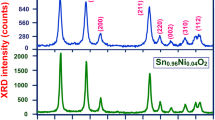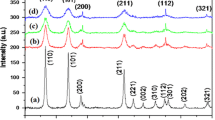Abstract
Optical bandgap narrowing is observed in Sn0.94 Zn0.05Co0.01O2, Sn0.92 Zn0.05Co0.03O2 and Sn0.90 Zn0.05Co0.05O2 nanoparticles synthesized by the chemical co- precipitation method. The estimated particle size and optical band gap of Sn0.94 Zn0.05Co0.01O2, Sn0.92 Zn0.05Co0.03O2 and Sn0.90 Zn0.05Co0.05O2 nanoparticles are 16.51, 11.75 and 6.6 nm and 1.45, 1.36 and 0.93 eV, respectively. A red shift is noticed for all samples as compared to band gap value (3.6 eV) for bulk SnO2. Increasing Co content results in decreased particle size, narrowed band gap and enhanced emission intensities in visible range of light. Small sized nano particles have larger surface areas and these large surface areas lead to more defects (oxygen vacancies, tin interstitials). The increasing defects concentration (especially oxygen vacancies, tin interstitials) results to narrow the band gap. With increasing Co content, the particles are in oxygen-poor state indicating the presence of many O vacancies and Sn interstitials. The oxygen content decreases steadily with increasing Co content, with the Sn:O atomic ratio increases suggesting the high density of defects. Large number of defects (oxygen vacancies) creates several donor levels within the forbidden energy gap to narrow the band gap and these defects in the band gap act as luminescent centers to enhance the emission intensities in visible spectrum.











Similar content being viewed by others
Change history
26 July 2017
An erratum to this article has been published.
References
A.K. Sinha, P.K. Manna, M. Pradhan, C. Mondal, S.M. Yusuf, T. Pal, Tin oxide with a p–n heterojunction ensures both UV and visible light photocatalytic activity. RSC Adv. 4, 208–211 (2014)
V.B. Kamble, A.M. Umarji, Defect induced optical bandgap narrowing in undoped SnO2 nanocrystals. AIP Adv. 3, 082120–082125 (2013)
D.S. Ginley, C. Bright, Transparent conducting oxides. MRS Bull. 25, 15–18 (2000)
T. Minami, New n-type transparent conducting Oxides. MRS Bull. 25, 38–44 (2000)
D.F. Cox, T.B. Fryberger, S. Semancik, Oxygen vacancies and defect electronic states on the SnO2(110)-1 × 1 surface. Phys. Rev. B: Condens. Matter 38, 2072–2085 (1988)
X. Chen, L. Liu, P.Y. Yu, S.S. Mao, Increasing solar absorption for photo-catalysis with black hydrogenated titanium dioxide nanocrystals. Science 331, 746–750 (2011)
M.M. Khan, S.A. Ansari, D. Pradhan, M.O. Ansari, D.H. Han, J. Lee, M.H. Cho, Band gap engineered TiO2 nanoparticles for visible light induced photo-electrochemical and photocatalytic studies. Mater. Chem. A 2, 637–644 (2014)
H. Rinnert, P. Miska, M. Vergnat, G. Schmerber, S. Colis, A. Dinia, D. Muller, G. Ferblantier, A. Slaoui, Photoluminescence of Nd-doped SnO2 thin films. Appl. Phys. Lett. 100, 101908 (2012). doi:10.1063/1.3692747
Z.M. Tian, S.L. Yuan, J.H. He, P. Li, S.Q. Zhang, C.H. Wang, Y.Q. Wang, S.Y. Yin, L. Liu, Structure and magnetic properties in Mn doped SnO2 nanoparticles synthesized by chemical co-precipitation method. J. Alloys Compd. 466, 26–30 (2008)
Y. Li, W. Yin, R. Deng, R. Chen, J. Chen, Q. Yan, B. Yao, H. Sun, S.H. Wei, T. Wu, Realizing a SnO2-based ultraviolet light-emitting diode via breaking the dipole-forbidden rule. NPG Asia Mater. 4, 1–6 (2012)
M.M. Khan, S.A. Ansari, D. Pradhan, M.O. Ansari, D.H. Han, J. Lee, M.H. Cho, Band gap engineered TiO2 nanoparticles for visible light induced photo-electrochemical and photocatalytic studies. Mater. Chem. A 2, 637–644 (2014)
R. Long, N.J. English, Synergistic effects on band gap-narrowing in Titania by co-doping from first-principles calculations. Chem. Mater. 22, 1616–1623 (2010)
J.G. Lu, Z.Z. Ye, Y.Z. Zhang, Q.L. Liang, S. Fujita, Z.L. Wang, Self-assembled ZnO quantum dots with tunable optical properties. Appl. Phys. Lett. 89, 023122 (2006)
J.G. Lu, Z.Z. Ye, J.Y. Huang, L.P. Zhu, B.H. Zhao, Z.L. Wang, S. Fujita, ZnO quantum dots synthesized by a vapor phase transport process. Appl. Phys. Lett. 88, 063110 (2006)
Zulfiqar, Y. Yuan, Q. Jiang, J. Yang, L. Feng, W. Wang, Z. Ye, J. Lu, Variation in luminescence and bandgap of Zn-doped SnO2 nanoparticles with thermal decomposition. J. Mater. Sci.: Mater. Electron. (2016). doi:10.1007/s10854-016-5006-3
R. Khan, Zulfiqar, S. Fashu, M.U. Rahman, Effects of Ni co-doping concentrations on dielectric and magnetic properties of (Co, Ni) co-doped SnO2 nanoparticles. J. Mater. Sci.: Mater. Electron. (2016). doi:10.1007/s10854-016-4759-z
R. Khan, Zulfiqar, Y. Zaman, Effect of annealing on structural, dielectric, transport and magnetic properties of (Zn, Co) co-doped SnO2 nanoparticles. J. Mater. Sci.: Mater. Electron. 27, 4003–4010 (2016)
R. Khan, Zulfiqar, S. Fashu, Y. Zaman, Magnetic and dielectric properties of (Co, Zn) co-doped SnO2 diluted magnetic semiconducting nanoparticles. J. Mater. Sci.: Mater. Electron. 27, 5960–5966 (2016)
R. Khan, Zulfiqar, S. Fashu, M.U. Rahman, Effects of Ni co-doping concentrations on dielectric and magnetic properties of (Co, Ni) co-doped SnO2 nanoparticles. J. Mater. Sci.: Mater. Electron. (2016). doi:10.1007/s10854-016-4759-z
P. Mohanapriya, R. Pradeepkumar, N. Jaya, T. Natarajan, Magnetic and optical properties of electro-spun hollow nano-fibers of SnO2 doped with Ce-ion. Appl. Phys. Lett. 105, 022406 (2014)
A. Punnoose, J. Hays, V. Gopal, V. Shutthanandan, Room-temperature ferromagnetism in chemically synthesized Sn1−x Co x O2 powders. Appl. Phys. Lett. 85, 1559–1561 (2004)
D.R. Leite, W.C. Las, G. Brankovic, M.A. Zaghete, M. Cilence, J.A. Varela, Use of impedance spectroscopy in the study of the effect of Cr concentration on the electrical properties of SnO2 based ceramics. Mater. Sci. Forum 498–499, 337–341 (2005)
J.A. Cerri, E.R. Leite, D. Gouvêa, E. Longo, Effect of cobalt(II) and manganese(IV) on sintering of tin(IV) oxide. J. Am. Ceram. Soc. 79, 799–804 (1996)
I.H. Gul, F. Amin, A.Z. Abbasi, M. Anis-ur-Rehman, A. Maqsood, Structural, dielectric, and magnetic characterization of nanocrystalline Ni–Co ferrites. Scr. Mater. 56, 497 (2007)
F. Gervais, W. Kress, Lattice dynamics of oxides with rutile structure and instabilities at the metal-semiconductor phase transitions of NbO2 and VO2. Phys. Rev. B 31, 4809–4814 (1985)
C.M. Liu, X.T. Zu, Q.M. Wei, L.M. Wang, Fabrication and characterization of wire-like SnO2. J. Phys. D Appl. Phys. 39, 2494–2497 (2006)
P. Wu, Q. Li, X. Zou, W. Cheng, D. Zhang, C. Zhao, L. Chi, T. Xiao, Correlation between photoluminescence and oxygen vacancies in In2O3, SnO2 and ZnO metal oxide nanostructures. Phys. Conf. Ser. 188, 012054–012058 (2009)
B. Jia, W. Jia, F. Qu, X. Wu, General strategy for self-assembly of mesoporous SnO2 nano-spheres and their applications in water purification. RSC Adv. 3, 12140–12148 (2013)
C. Cheng, G. Xu, H. Zhang, Y. Li, Y. Luo, P. Zhang, A simple route to synthesize multiform structures of tin oxide nano-belts and optical properties investigation. Mater. Sci. Eng. B 147, 79–83 (2008)
F. Gu, S. Wang, M. Lu, G. Zhou, D. Xu, D. Yuan, Photoluminescence properties of SnO2 nanoparticles synthesized by sol–gel method. J. Phys. Chem. B 108, 8119–8123 (2004)
J. Yang, J. Appl. Phys. 108, 1 (2010)
J. SuhuaLuo, W. Fan, M. Liu, Z. Zhang, C. Song, X. Lin, P. Wu, K. Chu, Synthesis and low-temperature photoluminescence properties of SnO2 nanowires and nanobelts. Nanotechnology 17, 1695–1699 (2006)
P. Wu, Q. Li, X. Zou, W. Cheng, D. Zhang, C. Zhao, L. Chi, T. Xiao, Correlation between photoluminescence and oxygen vacancies in In2O3, SnO2 and ZnO metal oxide nanostructures. J. Phys: Conf. Ser. 188, 012054–012058 (2009)
B. Dole, V. Mote, V. Huse, Y. Purushotham, M. Lande, K. Jadhav, S. Shah, Structural studies of Mn doped ZnO nanoparticles. J. Curr. Appl. Phys. 11, 762–766 (2011)
C.M. Fan, Y. Peng, Q. Zhu, L. Lin, R.X. Wang, A.W. Xu, Synproportionation reaction for the fabrication of Sn2+ self-doped SnO2−x nanocrystals with tunable band structure and highly efficient visible light photocatalytic activity. Phys. Chem. C 117, 24157–24166 (2013)
S. Kalathil, M.M. Khan, A.A. Sajid, M.H. Cho, J. Lee, Band gap narrowing of titanium dioxide (TiO2) nanocrystals by electrochemically active biofilm and their visible light activity. Nanoscale 5, 6323–6326 (2013)
S. Park, T. Ikegami, K. Ebihara, Thin Solid Films 513, 90 (2006)
M. Chen, X. Wang, Y.H. Yu, Z.L. Pei, X.D. Bai, C. Sun, R.F. Huang, L.S. Wen, Appl. Surf. Sci. 158, 134 (2000)
N. Li, K. Du, G. Liu, Y.P. Xie, G.M. Zhou, J. Zhu, F. Li, H.M. Cheng, Effects of oxygen vacancies on the electrochemical performance of tin oxide. J. Mater. Chem. A 1, 1536–1539 (2013)
Acknowledgments
This work was supported by National Natural Science Foundation of China under Grant No. 51372002.
Author information
Authors and Affiliations
Corresponding author
Additional information
An erratum to this article is available at https://doi.org/10.1007/s10854-017-7545-7.
Rights and permissions
About this article
Cite this article
Zulfiqar, Yuan, Y., Yang, J. et al. Structural and optical properties of (Zn, Co) co-doped SnO2 nano particles. J Mater Sci: Mater Electron 27, 12119–12127 (2016). https://doi.org/10.1007/s10854-016-5364-x
Received:
Accepted:
Published:
Issue Date:
DOI: https://doi.org/10.1007/s10854-016-5364-x




